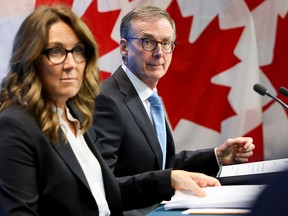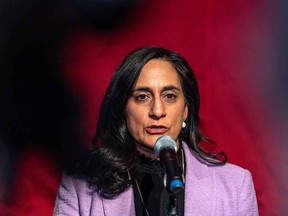Miran’s previous writings offer insights into Trump 2.0 playbook
Article content
U.S. President Donald Trump has promised to “overhaul” the U.S. approach to trade over the next four years in an effort to usher in a “golden era” for America, with threatened tariffs on Canada, Mexico and China among the earliest likely measures.
Article content
Article content
Those tariffs have already attracted criticism from economists, with many arguing they will be inflationary, make the American economy less efficient and ultimately harm U.S. economic growth.
Advertisement 2
Article content
So how does Trump rationalize the trade threats? Enter Stephen Miran, the man nominated in December to chair Trump’s Council of Economic Advisers (CEA).
Currently a senior strategist at Hudson Bay Capital Management LP and a fellow at the Manhattan Institute in New York City, Miran holds a PhD in economics from Harvard University and his dissertation advisor was Martin Feldstein, an eminent American economist who chaired the CEA during the Reagan administration.
In a report published in November entitled, ‘A user’s guide to restructuring the Global Trading System,’ Miran laid out several tariff scenarios that could be applied under a second Trump administration, and made the case for why they could still be effective despite some potential negative impacts.
Miran, who laid out the ideas before being nominated as an advisor, first points to Trump’s application of tariffs on China in 2018-2019, which he argues “passed with little discernible macroeconomic consequence.”
He adds that during that time the U.S. dollar rose to offset the macroeconomic impact of the tariffs and resulted in significant revenue for the U.S. Treasury.
Article content
Advertisement 3
Article content
“The effective tariff rate on Chinese imports increased by 17.9 percentage points from the start of the trade war in 2018 to the maximum tariff rate in 2019,” the report said. “As the financial markets digested the news, the Chinese renminbi depreciated against the dollar over this period by 13.7 per cent, so that the after-tariff USD import price rose by 4.1 per cent.”
Miran argues that the U.S. dollar has persistently been overvalued thanks to its status as a reserve currency. This has benefited financialized sectors of the economy and wealthy Americans, but put a burden on American manufacturing by making it cheaper to buy abroad.
While Trump has indicated his desire to maintain a strong dollar and preserve the greenback’s position as a reserve currency, Miran describes a solution in which the U.S. claws back more, both on trade and defence.
“I expect this tension to be resolved by policies that aim to preserve the status of the dollar, but improve burden sharing with our trading partners,” the report said. “International trade policy will attempt to recapture some of the benefit our reserve provision conveys to trading partners and connect this economic burden sharing with defence burden sharing.”
Advertisement 4
Article content
Miran says Trump believes other liberal democracies take advantage of America’s defence. As America’s economic share of global GDP shrinks, it becomes more difficult to underwrite that global security.
Trump has already connected national security concerns to trade policy. In November, he raised border concerns with Canada and Mexico, as an area that needs to be addressed for those countries to avoid tariffs.
Trump has also highlighted the need for NATO partners to commit to higher spending requirements on defence. On Thursday, Trump said he would ask NATO members to spend five per cent of their GDP on defence, a dramatic increase from the two per cent the U.S. has previously sought from defence partners.
When it comes to negotiation tactics, Miran also notes that in 2018, Trump did not implement the 25-per-cent tariff he threatened to impose on China in one action, instead opting for a more gradual approach. Miran says those tactics can be applied in any future trade disputes with China, if it does not meet U.S. demands.
“It might announce a schedule, for instance, a two per cent monthly increase in tariffs on China, in perpetuity, until the demands are met,” the report said.
Advertisement 5
Article content
Miran says the Trump administration can use a form of forward guidance when it comes to tariff policy, to avoid uncertainty.
To counter the inevitable problem of price competition for U.S. exporters, when the U.S. dollar appreciates because of tariffs, Miran argues the Trump administration can implement tax cuts to spur investment.
In a speech to the World Economic Forum on Thursday, Trump promised just that.
“My message to every business in the world is very simple, come make your product in America and we will give you among the lowest taxes of any nation on earth,” he said.
Recommended from Editorial
-

CEOs rush to bend the knee to Donald Trump
-

Hedge fund manager lines up for U.S. treasury secretary
Most notably, Miran argues the Trump administration will have to do what it can to avoid retaliatory tariffs, as they “nullify the welfare benefits of tariffs for the U.S.” However, he argues the U.S. would fare better than its counterparts in a trade war.
“Because the United States is a large source of consumer demand for the world with robust capital markets, it can withstand tit-for-tat escalation more easily than other nations and is likelier to win a game of chicken,” the report said.
Article content
Who is Stephen Miran, the economist who will lead Trump’s economics?
2025-01-24 19:35:48







